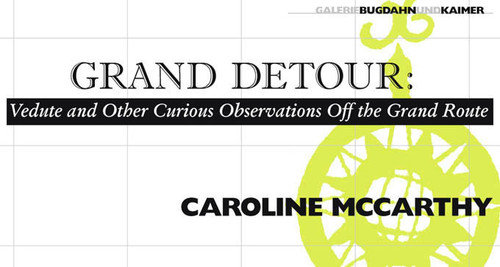Caroline McCarthy
dal 19/4/2007 al 25/5/2007
Segnalato da
19/4/2007
Caroline McCarthy
Galerie Bugdahn und Kaimer, Dusseldorf
Grand Detour: Vedute and Other Curious Observations Off the Grand Route

Grand Detour: Vedute and Other Curious Observations Off the Grand Route
Born in Ireland in 1971, Caroline McCarthy studied at the National College of Art & Design, Dublin, from 1989 to1994 and then, from 1997 to 1998, at Goldsmiths College in London, the city where she has been living and working since 1997. In her first solo showing outside the British and American sphere, Galerie Bugdahn und Kaimer presents a work completed in 2006, Grand Detour: Vedute and Other Curious Observations Off the Grand Route.
In the preceding, four major works, Escape (2002), From the Testors Military Range (2002), Still Life (2003) and Promise (2003), the artist combines materials and objects of the world outside into installations and assemblages. The notion of the Ready-made comes to mind as readily as an influence as do Pop and Appropriation Art; but quintessentially Caroline McCarthy belongs to a generation that has turned to subversive interventions and contextual shifts to alter ingrained ways of seeing and received readings. The focus has moved conspicuously from the sublime, the heroic and grandiose to emphasise the marginal, the seemingly insignificant, that place being taken in McCarthy’s work by discarded packaging material, for instance. For From the Testors Military Range the artist freed scrapped containers of detergents, motor oil, etc., of their labels and so of their brand identity, then lending them a new ‘skin’ in the gamut of military camouflage paints such as used by model-makers. In their painstakingly positioned arrangement on glass shelves, like precious items, the one-time empty containers now resemble video cameras and other technical apparatus. In Promise, McCarthy has joined assorted convenience-food packaging into a relief-like, rising field, a landscape of cardboard packaging material that to all appearances has decided to burst into growth overnight. Herbs used as a garnishing for meals were cut out of the photographs down to a small tab, to be popped upright and emerge from the integrated plastic flower pots like growing seedlings.
Grand Detour, the installation on view at the gallery, consists of one of the gallery walls, 6 x 3.2 metres primed in Venetian red, upon which some fifty-five framed drawings and watercolour paintings (10 x 15 – 20 x 30 cm) have been hung, and the simulation of a souvenir shop with printed T-shirts and matching caps, cards, CDs, catalogues and so on. The associations of ‘travel’ and ‘tourism’ invoked culminate in the wryly-put title in which the ‘grand tour’ of young eighteenth-century aristocrats transmutes into a ‘detour’, ‘off the grand route’, i.e., off the existing, ordained paths. Historically, travel was a luxurious and costly (and likely, arduous) affair which only a privileged section of society could afford; implicit in today’s comparatively democratic tourism is the ability to consume the entire globe in a series of short trips. Veduti were mementoes and objects of prestige – almost documentary, take-home views of cities and landscapes. Now McCarthy brings into play this genre with its filigree and highly skilled drawing and watercolour painting technique – but here too, she allows it to trip our eye: on the views of largely intimate scale, her chosen subjects more like staffage detail – weeds, rubble, packaging waste such as drink cans, plastic bottles, cartons, etc. This is the yield from her forays into the surroundings of Parker’s Box, her gallery in Brooklyn, New York, where she recorded in photographs taken in various locations what was to be processed in drawing later. To that extent the overall tableau also reproduces a kind of artistic map of the environment. For a considerable interval, the works are capable of making the viewer believe that what is on view is a select ensemble of diverse tourist attractions. The effect is due amongst other things to the horizon line which lies so low that the nigh-minute pictorial subjects – say, an empty burger box – loom before us almost like a monument out of classical Antiquity in its frontal or worm’s eye view. Added to which the artist in her ingenious and inimitable way manages to have her ‘miniature landscapes’ imitate the familiar traits of conventional landscape pictures; or rather, they fool our eye and brain into switching on the ready frame of the latter. In the place of the spectacular tourist ‘must-see’ ‘highlights’ are micro-views of chance, inconspicuous settings on the fringe, as found, which may be altered or even non-existent only days later.
Gabriele Wurzel
The Private View is on Friday, April 20, 6 – 9 pm.
Galerie Bugdahn und Kaimer
Düsseldorferstr. 6 D-40213 Düsseldorf
The Gallery is open Tuesday – Friday 12 noon – 6 pm, Saturday 12 noon – 4 pm; and by appointment



